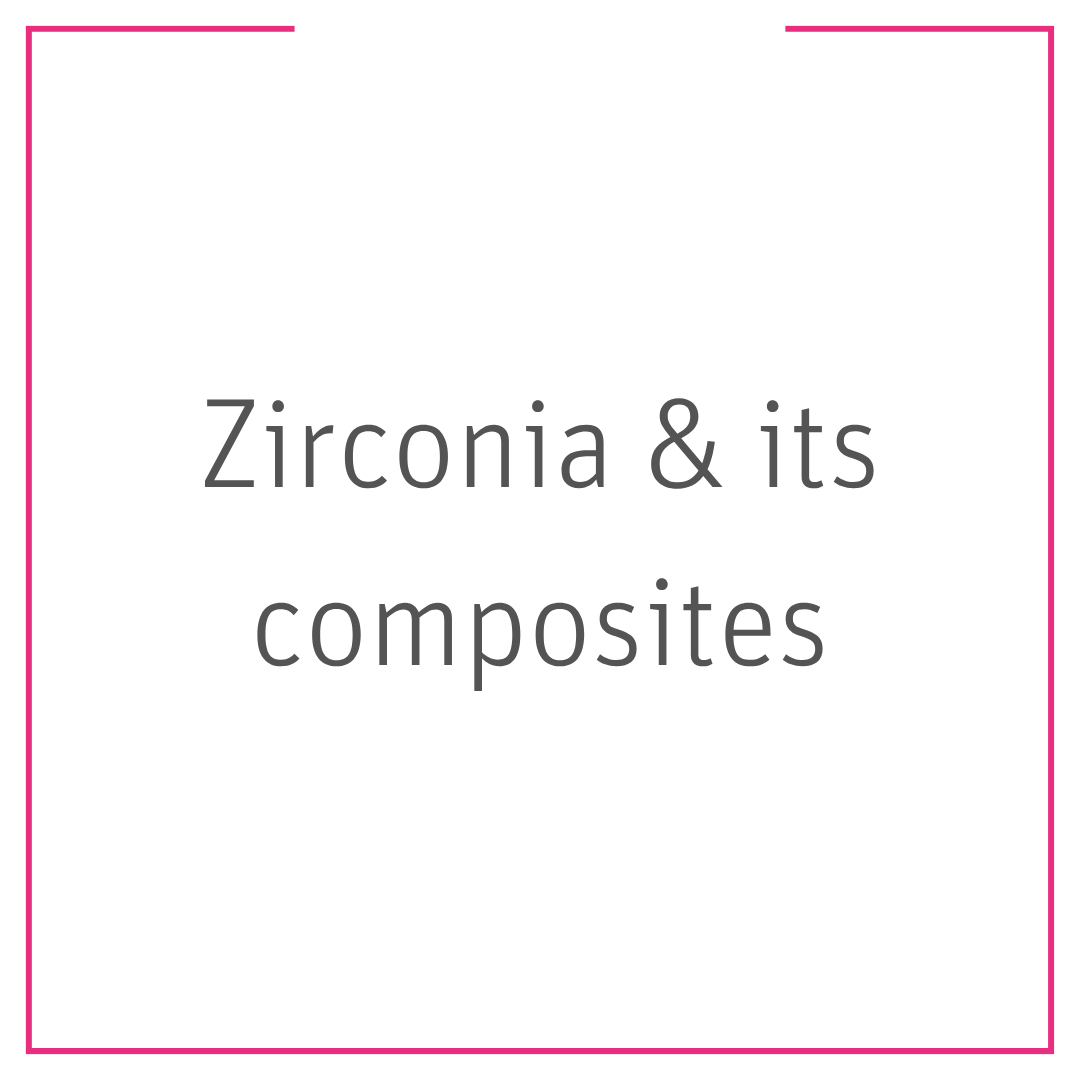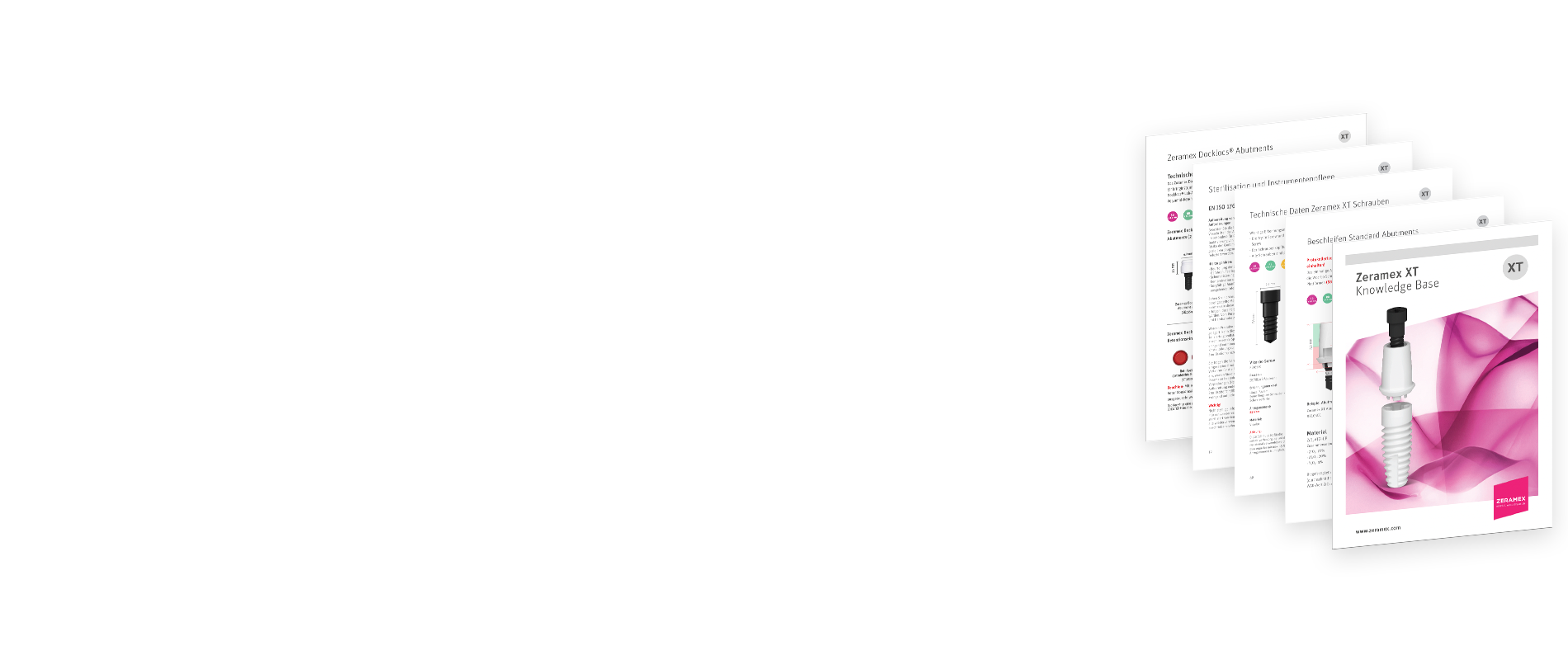Zirconium dioxide, tetragonal zirconia polycrystals (TZP-A), alumina-toughened zirconia (ATZ) – what is the difference?

> Zirconia and its composites: what do abbreviations TZP, TZP-A and ATZ mean?
> What is the current state of research regarding TZP-A & ATZ?
> What mechanical and biological advantages do ATZ & TZP-A ceramics provide?
> What material are Zeramex XT implants made of?
Zirconia and its composites: what doabbreviations TZP, TZP-A and ATZ mean?
The clinical application of modern zirconia-based ceramics is no longer limited to prosthetic restorations. Zirconium dioxide (known as zirconia) is also successfully used as an implant material and enables a metal-free restoration concept (Tartsch & Blatz 2022). Zirconia is characterised by high fracture resistance due to its high hardness and high flexural strength (Piconi & Maccauro 1999), excellent biocompatibility (Möller et al. 2012), improved aesthetic results (Cosgarea et al. 2015), hypoallergenicity (Pessanha-Andrade et al. 2018), wear and corrosion resistance (Sikora et al. 2018) and low plaque affinity and bacterial adhesion (Scarano et al. 2004). However, zirconia ceramics exist in various forms, each characterized by distinct mechanical properties that significantly affect the stability and longevity of implants and restorations in vivo.
Zirconium dioxide ZrO2 (not to be confused with zircon, a natural mineral consisting of zirconium silicate) is a synthetic composite material that is usually available in powder form. Zirconium dioxide powder is chemically extracted from minerals such as baddeleyite (ZrO2) and zirconate (ZrSiO4) (Linsmeier 2015). Pure zirconium dioxide belongs to the group of oxide ceramics and can occur in three allotropes or phases: monoclinic (m), tetragonal (t) and cubic (c). Monoclinic (m) refers to the stable phase up to 1170 °C. Above 1170 °C, a tetragonal phase occurs, and at temperatures above 2370 °C, a cubic (c) phase occurs. Pure zirconium dioxide, which is sintered at over 1170 °C (a thermal process in which the particles of a material are bonded to form a solid, dense structure), disintegrates during cooling due to cracking. To maintain the integrity of sintered zirconium dioxide bodies at room temperature, it is stabilised in the tetragonal phase at room temperature by alloying (Chevalier & Gremillard 2008).
The microcrystalline structure of zirconium dioxide initially exists in an unstable monoclinic phase. Hot isostatic pressing (HIP) of the powdered raw material into blanks at a pressure of up to 2000 bar and a temperature of 1170°C converts the unstable monoclinic phase into the stable tetragonal phase. At this point, the material is referred to as tetragonal zirconia polycrystal (TZP). The addition of 0.25% aluminium oxide (TZP-A) increases the flexural strength of TZP to up to 1200 MPa and improves its durability and stability at high temperatures and in humid environments (Ross et al. 2001; Li & Watanabe 1997; Tsubakino et al. 1991).
Increasing the alumina content from 0.25% to 20% increases the flexural strength of the material to > 1700 MPa. Alumina further stabilises this and reduces or blocks crack propagation (Chevalier 2006). At this point, the material is referred to as alumina-toughened zirconia (ATZ).
What is the current state of research regarding TZP-A & ATZ?
Current data indicates that dental implants made from ATZ and TZP-A can withstand physiological chewing forces over a period of 12.5 to 40 years (Spiess et al. 2015). At the same time, ATZ has several advantages over TZP-A.
- Schneider et al. (2008) point out that ATZ has a lower transformation rate compared to Y-TZP (Chevalier et al. 1999; Chevalier et al. 1997), with corresponding fracture strength and significantly higher flexural strength.
- ATZ (80% Y-TZP & 20% aluminium oxide) shows a slower ageing process in a humid atmosphere at body temperature after 50 years in vivo compared to 3Y-TZP, as investigated by Chevalier et al. (1997).
- ATZ implants show higher mechanical stability compared to implants made of TZP-A (Kohal et al. 2010).
- Artificial loading (10 million chewing cycles, corresponding to a clinical time frame of 12.5 to 40 years) and hydrothermal ageing (the test specimens were stored in distilled water heated to a constant temperature of 85 °C) do not reduce the fracture strength of the two-piece ATZ implants (Kohal et al. 2023).
What mechanical and biological advantages do ATZ & TZP-A ceramics provide?
ATZ & TZP-A are state-of-the-art materials characterised by high fracture resistance, high flexural strength (Piconi & Maccauro 1999), excellent biocompatibility (Möller et al. 2012), improved aesthetic results (Cosgarea et al. 2015), hypoallergenicity (Pessanha-Andrade et al. 2018) and wear and corrosion resistance (Sikora et al. 2018). In addition, the materials are characterised by durability and stability at high temperatures and in humid environments (Ross et al. 2001; Li & Watanabe 1997; Tsubakino et al. 1991).
What material are Zeramex XT implants made of?
Zeramex XT implants, including standard abutments, are made from ATZ (76 wt% ZrO2, 20 wt% Al2O3 & 4 wt% Y2O3).
References
Begand, S., Oberbach, T. & Glien, W. (2005). ATZ – Ein neues keramisches Material mit einem hohen Potenzial in der Gelenkendoprothetik*. Materials Testing, 47(4), 207-209. https://doi.org/10.3139/120.100649
Chevalier, B. Cales, and J. M. Drouin, "Low Temperature Aging of Y-TZP Ceramics," J. Am. Ceram. Soc., 82, 2150-4 (1999).
Chevalier, J., Liens, A., Reveron, H., Zhang, F., Reynaud, P., Douillard, T., ... & Courtois, N. (2020). Forty years after the promise of «ceramic steel?»: Zirconia‐based composites with a metal‐like mechanical behavior. Journal of the American Ceramic Society, 103(3), 1482-1513.
Chevalier, J., Gremillard, L., Virkar, A. V., & Clarke, D. R. (2009). The tetragonal‐monoclinic transformation in zirconia: lessons learned and future trends. Journal of the american ceramic society, 92(9), 1901-1920.
Chevalier J, Loh J, Gremillard L, Meille S, Adolfson E. Low-temperature degradation in zirconia with a porous surface. Acta Biomater. 2011 Jul;7(7):2986-93. doi: 10.1016/j.actbio.2011.03.006. Epub 2011 Mar 15. PMID: 21414426.
Chevalier, J., & Gremillard, L. (2008). Zirconia ceramics. In Bioceramics and their clinical applications (pp. 243-265). Woodhead Publishing.
Chevalier J. What future for zirconia as a biomaterial? Biomaterials 2006;27:535−543.
Chevalier, J. M. Drouin, and B. Cales, "Low Temperature Aging Behavior of Zirconia Hip Joint Heads," Bioceramics, 10, 135-8 (1997) ISBN 0080426921.
Cosgarea R, Gasparik C, Dudea D, Culic B, Dannewitz B, Sculean A. Peri-implant soft tissue colour around titanium and zirconia abutments: a prospective randomized controlled clinical study. Clin Oral Implants Res. 2015;26(5):537-544. doi:10.1111/clr.12440.
Deville, S., Chevalier, J., Fantozzi, G., Bartolomé, J. F., Requena, J., Moya, J. S., ... & Dı́az, L. A. (2003). Low-temperature ageing of zirconia-toughened alumina ceramics and its implication in biomedical implants. Journal of the European Ceramic Society, 23(15), 2975-2982.
Deville, S., El Attaoui, H., & Chevalier, J. (2005). Atomic force microscopy of transformation toughening in ceria-stabilized zirconia. Journal of the European Ceramic Society, 25(13), 3089-3096.
C. Garvie, R. H. J. Hannink, and R. T. Pascoe, ‘‘Ceramic Steel,’’ Nature, 258, 703–4 (1975).
Green, D. J.; Hannink, R.; Swain, M. V. (1989). Transformation Toughening of Ceramics. Boca Raton: CRC Press. ISBN 0-8493-6594-5.
Kern, F. R. A. N. K., & Gadow, R. A. I. N. E. R. (2013). Mechanical properties and low temperature degradation resistance of 2.5 Y-TZP–alumina composites. Materiały Ceramiczne, 65(3), 258-266.
Kohal RJ, Schikofski T, Adolfsson E, Vach K, Patzelt SBM, Nold J, Wemken G. Fracture Resistance of a Two-Piece Zirconia Implant System after Artificial Loading and/or Hydrothermal Aging-An In Vitro Investigation. J Funct Biomater. 2023 Dec 15;14(12):567. doi: 10.3390/jfb14120567. PMID: 38132821; PMCID: PMC10743638.
Kohal RJ, Wolkewitz M, Mueller C. Alumina-reinforced zirconia implants: survival rate and fracture strength in a masticatory simulation trial. Clin Oral Implants Res. 2010 Dec;21(12):1345-52. doi: 10.1111/j.1600-0501.2010.01954.x. PMID: 20626420.
Lawson, S. (1995). Environmental degradation of zirconia ceramics. Journal of the European ceramic society, 15(6), 485-502.
Li L.F., Watanabe R. Influence of a small amount of Al2O3 addition on the transformation of Y2O3-partially stabilized ZrO2 during annealing. J. Mater. Sci. 1997;32:1149–1153. doi: 10.1023/A:1018567414745.
Linsmeier, K.-D. (2015). Technische Keramik. 3. Akt. Auflage. Verlag Moderne Industrie
Möller B, Terheyden H, Açil Y, et al. A comparison of biocompatibility and osseointegration of ceramic and titanium implants: an in vivo and in vitro study. Int J Oral Maxillofac Surg. 2012;41(5):638-645. doi:10.1016/j.ijom.2012.02.004.
Noumbissi S, Scarano A, Gupta S. A Literature review study on atomic ions dissolution of titanium and its alloys in implant dentistry. Materials (Basel). 2019;12(3):368. doi:10.3390/ma12030368.
Pessanha-Andrade M, Sordi MB, Henriques B, Silva FS, Teughels W, Souza JCM. Custom-made root-analogue zirconia implants: a scoping review on mechanical and biological benefits. J Biomed Mater Res B Appl Biomater. 2018;106(8):2888-2900. doi:10.1002/jbm.b.34147.
Piconi C, Maccauro G. Zirconia as a ceramic biomaterial. Biomaterials. 1999;20(1):1-25. doi:10.1016/s0142-9612(98)00010-6.
Ross I.M., Rainforth W.M., McComb D.W., Scott A.J., Brydson R. The role of trace additions of alumina to yttria-tetragonal zirconia polycrystal (Y-TZP) Scr. Mater. 2001;45:653–660. doi: 10.1016/S1359-6462(01)01076-4
Scarano A et al., Bacterial adhesion on commercially pure titanium and zirconium oxide disks: an in vivo human study. J Periodontol. 2004 Feb; 75(2):292-6.
Sikora CL, Alfaro MF, Yuan JC, Barao VA, Sukotjo C, Mathew MT. Wear and corrosion interactions at the titanium/zirconia interface: dental implant application. J Prosthodont. 2018;27(9):842-852. doi:10.1111/jopr.12769.
Spies BC, Sauter C, Wolkewitz M, Kohal RJ. Alumina reinforced zirconia implants: effects of cyclic loading and abutment modification on fracture resistance. Dent Mater. 2015 Mar;31(3):262-72. doi: 10.1016/j.dental.2014.12.013. Epub 2015 Jan 9. PMID: 25582058.
Schneider J, Begand S, Kriegel R, et al. Low-temperature aging behavior of alumina-toughened zirconia. J Am Ceram Soc. 2008;91(11):3613-3618.
Tsubakino H., Nozato R., Hamamoto M. Effect of alumina addition on the tetragonal-to-monoclinic phase transformation in zirconia–3 mol % yttria. J. Am. Ceram. Soc. 1991;74:440–443. doi: 10.1111/j.1151-2916.1991.tb06905.x.
Didn't find the answer to your question?
Leave a comment
Comments
No comments have been posted yet.


